 |
 |
 |
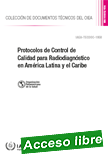 |
Protocolos de Control de Calidad para Radiodiagnóstico en América Latina y el Caribe
IAEA ¦ TECDOC-1958 ¦ Spanish ¦ Date published: 2021 ¦ 204 pages ¦ 118 Figures
Protocolos de control de calidad para radiodiagnóstico en América Latina y el Caribe considera y actualiza procedimientos técnicos, de acuerdo con la evolución e incorporación de nuevas tecnologías en la región, así como el aumento en el número de equipos emisores de rayos X en los ámbitos de la radiología general, la dental, la mamografía, la tomografía y el intervencionismo.
|
La obra consta de siete capítulos en los que se detallan los procedimientos para la evaluación y el control de la calidad de los equipos de radiología analógica y digital de radiodiagnóstico, incluye una introducción y aborda las prácticas más relevantes, como la radiología general, la dental (incluida la intraoral), la panorámica, la cefalométrica y la de haz cónico. La publicación también se ocupa de la mamografía, los equipos de fluoroscopía convencional y el intervencionismo, así como de la tomografía computarizada, los cuartos oscuros y los medios de visualización de imágenes y las impresoras. Esta publicación está concebida como obra de consulta para físicos médicos, tecnólogos y profesionales que brindan servicios de control de la calidad de los equipos de radiodiagnóstico de la región de América Latina y el Caribe.
|
 |
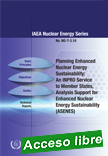 |
Planning Enhanced Nuclear Energy Sustainability
IAEA Nuclear Energy Series NG-T-3.19 ¦ STI/PUB/1939 ¦ 51 pages ¦ Date published: 2021
The main objective of this publication is to describe the purpose and scope of the INPRO service Analysis Support for Enhanced Nuclear Energy Sustainability (ASENES) and its potential benefits to Member States. The publication also highlights the linkage of this service to the overall technical support offered to Member States for the planning and development of nuclear energy, and how it integrates with other IAEA services supporting knowledgeable decision making on nuclear power.
|
Guidance provided here, describing good practices, represents expert opinion but does not constitute recommendations made on the basis of a consensus of Member States.
|
 |
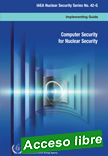 |
Computer Security for Nuclear Security
IAEA Nuclear Security Series No. 42-G ¦ STI/PUB/1918 ¦ 86 pages ¦ Date published: 2021
This publication provides detailed guidance on developing, implementing, and integrating computer security as a key component of nuclear security. This guidance applies to computer security aspects of nuclear security and its interfaces with nuclear safety and with other elements of a State’s nuclear security regime, including the security of nuclear material and nuclear facilities, of radioactive material and associated facilities, and of nuclear and other radioactive material outside of regulatory control.
|
The scope of this publication includes: computer-based systems, the compromise of which could adversely affect nuclear security or nuclear safety; the State’s and relevant entities roles and responsibilities in relation to computer security in the nuclear security regime; the activities of the State in establishing and implementing a computer security strategy for nuclear security; the elements and measures for subordinate computer security programmes; and the activities to sustain the strategy.
|
 |
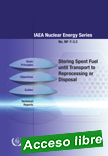 |
Storing Spent Fuel until Transport to Reprocessing or Disposal
IAEA ¦ STI/PUB/1846 ¦ Date published: 2021 ¦ 40 pages
This publication identifies issues and challenges relevant to the development and implementation of options, policies, strategies and programmes for ensuring safe, secure and effective storage of spent fuel until transport for reprocessing or disposal. The target audience of this publication includes policy and decision makers who need to be aware of the implicit risks and costs associated with decision timing for determining and implementing an end point for spent fuel management (such as reprocessing or disposal) to ensure the responsible and sustainable use of nuclear energy.
|
The publication will assist those within the nuclear industry in communicating the importance of a clear, credible and sustainable spent fuel management strategy and will encourage decision makers to consider different approaches that may be useful in addressing the uncertainties resulting from an unknown storage duration and an undefined end point for spent fuel management.
|
 |
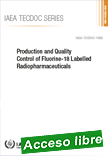 |
Production and Quality Control of Fluorine-18 Labelled Radiopharmaceuticals
IAEA-TECDOC-1968 ¦ 116 pages ¦ 118 Figures ¦ Date published: 2021
Since their clinical use initiation in the 1970’s, Fluorine-18 (F-18) radiopharmaceuticals continue to play an important role in nuclear medicine. It is therefore essential to make available broad information on practical production routes and optimal quality control for F- 18 tracers, to achieve the best possible products in high quantity and quality for clinical applications while fulfilling all regulatory requirements.
|
This publication describes the chemical and biological properties of F-18 radiopharmaceuticals. This includes aspects relating to F-18 target production and radiofluorination methods, with focus on the applied techniques. The publication presents a disease oriented approach, describing F-18 radiopharmaceuticals, ranging from the physiological/biological aspects to dedicated radiopharmaceutical development approaches and provides readers with clear guidelines and methods for the production of F-18 radiopharmaceuticals.
|
 |
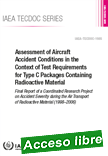 |
Assessment of Aircraft Accident Conditions in the Context of Test Requirements for Type C Packages Containing Radioactive Material
IAEA-TECDOC-1965 ¦ Date published: 2021 ¦ 144 pages
The IAEA Regulations for the safe transport of radioactive material specify test requirements for Type C packages, which are used for shipments of radioactive material by air. From 1998 to 2006, the IAEA conducted a coordinated research project (CRP) to assess aircraft accident frequency and severity in the context of Type C package test requirements.
|
This publication presents the outcome of the original research conducted under the CRP. The results are expected to lead to increased knowledge of the post-crash survivability of packages containing high activity radioactive material.
|
 |
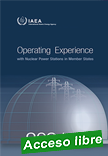 |
Operating Experience with Nuclear Power Stations in Member
IAEA/OPEX/2021 ¦ Date published: 2021 ¦ 1.619 pages
This report contains the 52nd edition of the IAEA’s series of annual reports on operating experience with nuclear power plants in Member States. It is a direct output from the IAEA’s Power Reactor Information System (PRIS) and contains information on electricity production and overall performance of individual plants during 2020. In addition to annual information, the report contains a historical summary of performance during the lifetime of individual plants and figures illustrating worldwide performance of the nuclear industry.
|
Design characteristics and dashboards of all operating nuclear power plants worldwide are also presented.
|
 |
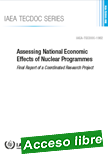 |
Assessing National Economic Effects of Nuclear Programmes
IAEA-TECDOC-1962 ¦ 142 pages ¦ Date published: 2021
This publication presents the outcomes of an IAEA coordinated research project on assessing the national economic effects of nuclear programmes in participating Member States. It provides a short description of the extended input–output model for sustainable power generation (EMPOWER), developed by the IAEA, and presents concise summaries of its applications. It further includes the results produced by the contributing research teams and summarizes general insights drawn from the national studies.
|
The publication illustrates the state of the art of assessing macroeconomic impacts of nuclear energy programmes. It is expected to support further applications of advanced models to improve the understanding of macroeconomic and sectoral impacts of building and operating nuclear power plants.
|
 |
 |
Nuclear Power Reactors in the World
IAEA-RDS-2/41 Reference Data Series No. 2 ¦ 84 pages ¦ Date published: 2021
This is the 41st edition of Reference Data Series No. 2, which presents the most recent reactor data available to the IAEA. It contains summarized information as of the end of 2020 on power reactors operating, under construction and shut down as well as performance data on reactors operating in the IAEA Member States.
|
The information is collected through designated national correspondents in the Member States and the data are used to maintain the IAEA's Power Reactor Information System (PRIS).
|
 |
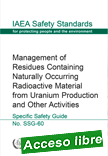 |
Management of Residues Containing Naturally Occurring Radioactive Material from Uranium Production and Other Activities
IAEA ¦ STI/PUB/1883 ¦ Date published: 2021 ¦ 108 pages
This Safety Guide provides recommendations on the establishment of an appropriate regulatory framework for the management of naturally occurring radioactive material (NORM) residues in an integrated manner and using a graded approach. It also elaborates on roles and responsibilities, options for management of NORM residues, long term safety of NORM residues, and exemption and clearance.
|
The publication is targeted at regulatory bodies, operating organizations, technical support organizations and other parties who are interested and involved in management of NORM residues.
|
 |
| |
|
|

|
|
|
| |
|
|
| |
| |
|
|
| |
| |
|
|
| |
| |
|
|
|
| |
| |
